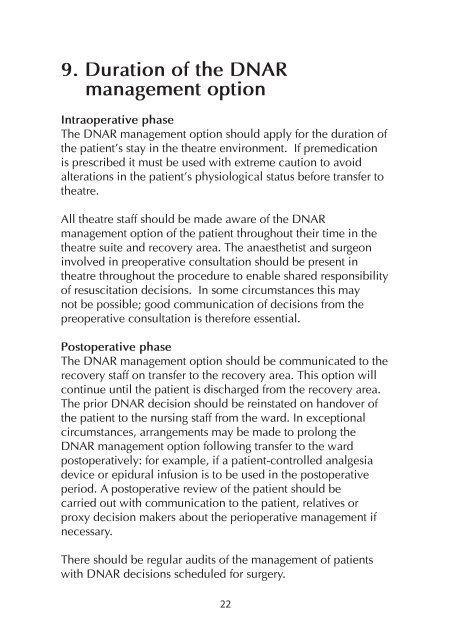Do Not Attempt Resuscitation (DNAR) Decisions in the ... - aagbi
Do Not Attempt Resuscitation (DNAR) Decisions in the ... - aagbi
Do Not Attempt Resuscitation (DNAR) Decisions in the ... - aagbi
Create successful ePaper yourself
Turn your PDF publications into a flip-book with our unique Google optimized e-Paper software.
9. Duration of <strong>the</strong> <strong>DNAR</strong><br />
management option<br />
Intraoperative phase<br />
The <strong>DNAR</strong> management option should apply for <strong>the</strong> duration of<br />
<strong>the</strong> patient’s stay <strong>in</strong> <strong>the</strong> <strong>the</strong>atre environment. If premedication<br />
is prescribed it must be used with extreme caution to avoid<br />
alterations <strong>in</strong> <strong>the</strong> patient’s physiological status before transfer to<br />
<strong>the</strong>atre.<br />
All <strong>the</strong>atre staff should be made aware of <strong>the</strong> <strong>DNAR</strong><br />
management option of <strong>the</strong> patient throughout <strong>the</strong>ir time <strong>in</strong> <strong>the</strong><br />
<strong>the</strong>atre suite and recovery area. The anaes<strong>the</strong>tist and surgeon<br />
<strong>in</strong>volved <strong>in</strong> preoperative consultation should be present <strong>in</strong><br />
<strong>the</strong>atre throughout <strong>the</strong> procedure to enable shared responsibility<br />
of resuscitation decisions. In some circumstances this may<br />
not be possible; good communication of decisions from <strong>the</strong><br />
preoperative consultation is <strong>the</strong>refore essential.<br />
Postoperative phase<br />
The <strong>DNAR</strong> management option should be communicated to <strong>the</strong><br />
recovery staff on transfer to <strong>the</strong> recovery area. This option will<br />
cont<strong>in</strong>ue until <strong>the</strong> patient is discharged from <strong>the</strong> recovery area.<br />
The prior <strong>DNAR</strong> decision should be re<strong>in</strong>stated on handover of<br />
<strong>the</strong> patient to <strong>the</strong> nurs<strong>in</strong>g staff from <strong>the</strong> ward. In exceptional<br />
circumstances, arrangements may be made to prolong <strong>the</strong><br />
<strong>DNAR</strong> management option follow<strong>in</strong>g transfer to <strong>the</strong> ward<br />
postoperatively: for example, if a patient-controlled analgesia<br />
device or epidural <strong>in</strong>fusion is to be used <strong>in</strong> <strong>the</strong> postoperative<br />
period. A postoperative review of <strong>the</strong> patient should be<br />
carried out with communication to <strong>the</strong> patient, relatives or<br />
proxy decision makers about <strong>the</strong> perioperative management if<br />
necessary.<br />
There should be regular audits of <strong>the</strong> management of patients<br />
with <strong>DNAR</strong> decisions scheduled for surgery.<br />
22

















